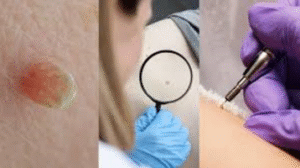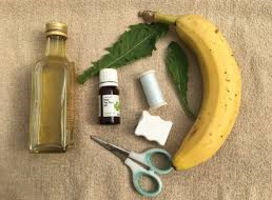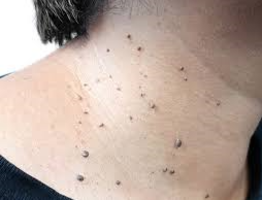Have you ever caught yourself avoiding certain necklines or constantly adjusting your collar to hide those pesky little skin growths? I know that feeling all too well. For years, I was embarrassed by skin tags that seemed to appear out of nowhere along my neck and face. Every morning, I’d stare in the mirror, wishing they would magically disappear.
The good news? You don’t have to live with them forever. I managed to eliminate mine quickly and safely, and you can too. I’ll walk you through everything I discovered about getting rid of skin tags fast – from professional treatments to effective home remedies that actually work.
I’ll share my personal journey of being embarrassed by skin tags and how I finally found solutions that gave me back my confidence.

What Are Skin Tags and Why Do We Get Them?
Skin tags are small, benign growths that typically appear in areas where skin rubs against skin or clothing. They’re mostly loose collagen fibers and blood vessels skin around them.
Common locations for skin tags include:
- Neck
- Armpits
- Eyelids
- Under breasts
- Groin folds
- Upper chest
Why do we develop skin tags?
Several factors contribute to their formation:
- Friction: Skin tags are most common in places where skin regularly brushes against clothing or other skin.
- Weight gain: Being overweight increases your risk, as you have more skin folds.
- Age: Skin tags become more common as we age, particularly after 40.
- Pregnancy: Skin tags might form as a result of hormonal changes during pregnancy.
- Genetics: If your family members have skin tags, you’re more likely to develop them too.
- Insulin resistance: Conditions like diabetes or metabolic syndrome are associated with increased skin tag formation.
I was particularly embarrassed by skin tags that appeared along my neckline in my mid-30s. For me, it seemed to be a combination of genetics and the friction from necklaces I wore daily. Understanding why they appear helped me address the root causes while working on removal solutions.
Professional Methods: How I Got Rid of My Skin Tags Fast
When I decided to tackle my skin tag situation, I first consulted with a dermatologist. While some people prefer home remedies, I wanted to start with professional guidance, especially for the more visible tags on my neck.
Here are the medical methods my dermatologist recommended, including the one I ultimately chose:
Cryotherapy (Freezing)
The dermatologist suggested liquid nitrogen to freeze the skin tags, which will cause them to fall off within 1-2 weeks.
- Fast process (less than five minutes for each tag)
- Minimal discomfort during treatment
- No bleeding or cutting involved
- Cost was about $100-150 per session
- For larger skin tags, it was ideal.
Electrocautery
This uses an electric current to burn off the skin tag (this is the option I chose, watch the video below).
- Quick procedure
- Local anesthetic is applied first
- Seals blood vessels as it removes the tag
- Minimal scarring in most cases
- Best for medium-sized skin tags
Surgical Excision
For very large skin tags, It may be advised to remove it surgically using a scalpel or sterile scissors. More invasive than other methods
- Local anesthetic is used
- Provides immediate results
- May leave a small scar
- Best for large or unusually shaped tags

Ligation
Using surgical thread, the base of the skin tag is tied off, stopping blood flow until the tag comes off.
- Takes a few days to work
- Minimal pain
- Can be done in-office
- Less expensive than some other methods
- Effective with skin tags that have a distinct stalk
Effective Home Remedies That Helped Me Get Rid of Skin Tags
After my professional treatment for the larger skin tags, I still had several smaller ones that I wanted to address without making additional dermatologist appointments. Through research and careful experimentation, I found several home remedies that proved effective for my minor skin tags:

Apple Cider Vinegar Method
This was my go-to method for several small skin tags on my underarms, how to apply:
- Cleanse the area thoroughly
- Collect some apple cider vinegar with a cotton ball
- Apply directly to the skin tag
- Secure with a bandage overnight
- Repeat for 3-4 nights until the tag darkens and falls off
Tea Tree Oil Application
For a few stubborn tags along my neck, how to apply:
- To dilute tea tree oil, use a carrier oil, such as coconut oil.
- Mix well, use a cotton swab to apply to the skin tag
- Cover with a bandage
- Apply 2-3 times daily
- Results appeared after about 1-2 weeks of consistent application
Banana Peel Method
This might sound unusual, but it was surprisingly effective for a small tag near my eye, how to apply:
- Cut off a tiny piece of banana peel, then press the peel’s inside up against the skin tag.
- Secure with a bandage overnight
- Over the course of 10–14 days of nightly application, the skin tag was gradually broken down by the peel’s enzymes.
Vitamin E Approach
For prevention and addressing very small tags,how to apply:
- Break open a vitamin E capsule
- To the skin tag, apply the oil directly
- Massage gently for 2-3 minutes
- Apply twice daily
- Helps soften the tag and may cause it to diminish over time
Important safety tips for home remedies
- Never attempt to remove skin tags near the eyes without professional help
- Stop any treatment that causes excessive pain, bleeding, or irritation
- Before attempting home treatments, people with diabetes should speak with a doctor
- Always patch test any substance on a small area of skin first
- Keep an eye out for symptoms of infection, such as unusual discharge, swelling, or redness.
I found that being consistent with these home treatments was key. While they worked more slowly than professional methods, they were effective for smaller skin tags and much more budget-friendly.
My Personal Skin Tag Prevention Strategy
After successfully removing my skin tags, I became determined to prevent new ones from forming. Through research and personal experimentation, I developed a prevention strategy that has significantly reduced new skin tag formation. They include:
Daily Skin Care Routine
- Gentle cleansing of prone areas with non-irritating cleansers
- Regular exfoliation (1-2 times weekly) to remove dead skin cells
- Maintaining the skin’s suppleness by using non-comedogenic moisturizers.
- Apply talcum powder to areas that are prone to friction and moisture
Lifestyle Adjustments
- Keeping a healthy weight by eating a balanced diet
- Regular exercise to improve circulation and metabolism
- Wearing loose-fitting clothing to reduce friction
- Avoiding heavy necklaces or clothing that constantly rubs against the neck
- Diet and exercise to manage blood sugar levels
Targeted Supplements
- Vitamin A (helps turnover of healthy skin cell)
- Vitamin E (antioxidant properties for skin health)
- Omega-3 fatty acids (reduces inflammation)
- Zinc (assists in skin healing and immunological function)
Regular Skin Checks
- Monthly self-examinations to catch new tags early
- Taking photos of prone areas to track changes
- Addressing new tags while they’re still small
When to See a Doctor
See a doctor if your skin tag:
- Changes color (especially if it becomes very dark or multicolored)
- Bleeds unexpectedly or without provocation
- Grows rapidly or changes shape
- Becomes painful or itchy
- Has an unusual appearance compared to your other skin tags
- Is located in a very sensitive area like genitals or eyelids
- Gets repeatedly irritated or infected
Medical conditions requiring professional evaluation:
- You have diabetes or insulin resistance
- You have a compromised immune system
- You have a bleeding disorder
- You’re experiencing multiple skin tags appearing suddenly
- The occurrence of skin cancer runs in your family.
FAQs
Are skin tags a sign of diabetes?
While skin tags themselves don’t cause diabetes, there is a correlation between the two conditions. Research suggests that people with insulin resistance, prediabetes, or type 2 diabetes often have more skin tags than the general population. This connection is believed to be related to insulin’s growth-promoting effects and inflammation.
If you suddenly develop multiple skin tags, especially around your neck or armpits, it might be worth getting your blood sugar levels checked.
Can I use scissors at home to cut off a skin tag?
While you technically could cut off a skin tag at home, medical professionals strongly advise against this practice. Cutting skin tags yourself carries significant risks: potential excessive bleeding (especially if you’re on blood thinners), infection, improper removal leaving behind cells that can regrow, and unnecessary scarring. The pain can also be substantial without proper anesthesia.
If you’re embarrassed by skin tags and want them removed quickly, it’s safer to see a dermatologist who can remove them properly with sterile tools and appropriate techniques, or try one of the gentler home remedies mentioned in this article.
Do skin tags grow back after removal?
A specific skin tag will not grow back, if it’s been completely removed, however, new skin tags can form in the same area or elsewhere on your body. This often leads people to believe their removed tags have returned, when in fact, they’re experiencing new growths.
If you were embarrassed by skin tags and had them professionally removed, but notice new growths appearing, it’s likely due to the same factors that caused the original tags – friction, hormonal shifts, genetic predispositions, or variations in weight.
How long does it take for apple cider vinegar to cause a skin tag to come off?
When using apple cider vinegar to remove skin tags, timing varies depending on the size of the tag and consistency of application. Typically, you’ll notice the skin tag changing color within 1-3 days, darkening or becoming more pronounced.
With consistent nightly application, smaller skin tags often dry up and fall off within 5-7 days. Larger tags might take 2-4 weeks of regular treatment.
Can skin tags be cancerous?
True skin tags (acrochordons) are benign growths and are not cancerous. They do not transform into cancer over time. However, it’s important to note that not all skin growths that appear to be skin tags actually are skin tags.
Some more serious conditions like seborrheic keratosis, moles, or even certain forms of skin cancer can sometimes be mistaken for skin tags by untrained eyes.
Conclusion…
My journey from being embarrassed by skin tags to feeling confident again wasn’t just about physical removal – it was about taking control of something that had affected my self-image for too long. Through professional treatments, effective home remedies, and preventive measures, I successfully addressed skin tags that had been a source of insecurity for years.
If you’re currently feeling embarrassed by skin tags, I hope my experience has shown you that effective solutions exist. Whether you choose professional removal, home remedies, or a combination approach like I did, know that you don’t have to live with skin tags that affect your confidence.



